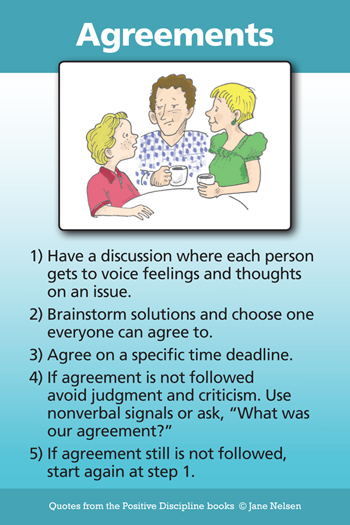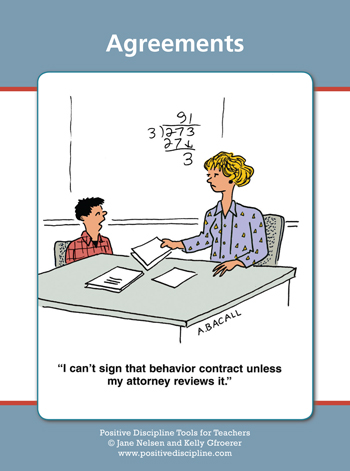Why don’t children keep their agreements? Could it be that sometimes parents and teachers say, “This is what we are going to do. Do you agree?” When the question is asked in an authoritarian manner that doesn’t leave room for discussion, children often shrug in agreement, which really means, “Sure, I’ll agree to get you off my back, but I don’t really agree.”
Involvement=Cooperation
Children will usually keep their agreements when they have been respectfully involved in creating the agreements, which requires several steps. The reason for the word “usually” will be discussed later.
- Sit down together during a calm time (not at the time of conflict) and have a respectful discussion about the issue that requires an agreement. It is important to wait until everyone has calmed down before a rational discussion can be achieved.
- During the discussion time, be sure that everyone has an opportunity to share his or her thoughts and feelings about the issue. Interruptions are not allowed when someone is sharing. Some families use a three minute sand flow timer. The person who is sharing can have the whole three minutes, or can stop before his or her time is up by saying so. The person or people listening are not allowed to defend, explain, or give their opinion until it is their turn.
- Brainstorming comes only after everyone has had a chance to share. Make brainstorming fun where any suggestion is written down—no matter how wild or crazy. Do not give opinions about brainstorm ideas. This is not the time for discussion. Just get lots of ideas written down on paper. It is a good idea to focus on solutions.
- During agreement time, it is okay to discuss the pros and cons of each brainstormed idea. You might start by asking:
- Is there anything that should be eliminated because it is not practical? (Perhaps you can’t afford it, or you don’t have other resources available to accomplish the idea.)
- Is there anything that should be eliminated because it is disrespectful to anyone involved?
- Is there anything that should be eliminated because it wouldn’t really solve the problem?
- Hopefully there will be some suggestions left. Choose one that everyone can agree to.
- If appropriate, choose an exact time for completion of the agreement. For example, if your daughter agreed to mow the lawn, negotiate for a time that works for both of you.
- When an agreement isn’t kept, respectfully ask, “What was our agreement?” Read on to discover why this may be necessary.
The reason children “usually” keep their agreements when they have been respectfully involved is because children are children. Even when they really do intend to keep their agreements, they don’t have the same priorities as adults. They may intend to mow the lawn, but since it is not high on their priority list, it may be “forgotten.” How often do you get to the items you should do, but that are not high on your list of priorities? Since having the lawn mowed is high on your priority list, and since you have respectfully involved your child in creating an agreement, which included a specific deadline; it is okay to respectfully ask your child, “What was our agreement?”
If these steps don’t promote successful agreement, start again from the top. During step two you may discover the reasons—and you will be giving everyone an opportunity to keep learning from mistakes.
For Teachers
You can make agreements with individual students or with the whole class. The process is the same.
1. Have a friendly discussion where students and teacher can each voice their feelings and thoughts.
2. Brainstorm together for solutions and find one that everyone agrees to try.
3. Involvement increases commitment.
4. Agree on a timeline.
5. Check in at the agreed upon time (or during the next Class Meeting) to see how things are going.
6. If an agreement is not being followed, ask, “What was our agreement?” This usually serves as a friendly reminder.
7. If the agreement does not work go through the steps again, starting with a discussion of why it didn’t work.
Click Here for the Teacher Tool Cards.



No Comments yet!